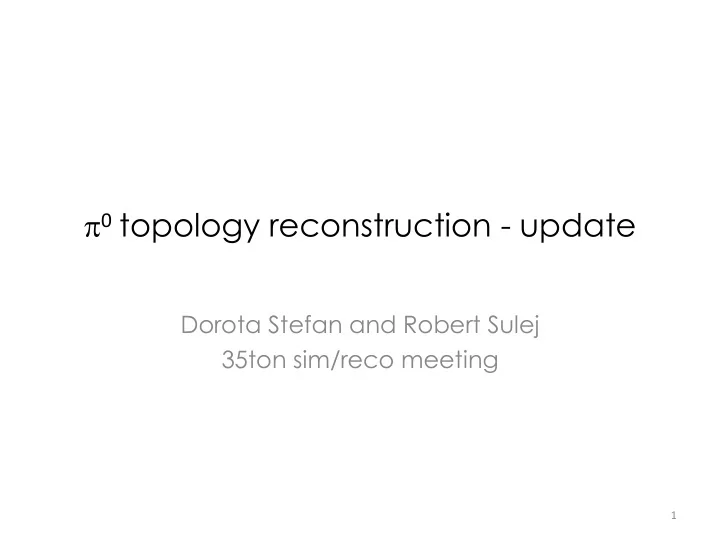

p 0 topology reconstruction - update Dorota Stefan and Robert Sulej 35ton sim/reco meeting 1
p 0 reconstruction chain in 35t Hadronic interactions, cosmic muons: track reconstruction – subtraction of hadron/muon hits at 3d level. • Would be nice to do it at the 2d level. vertices reconstruction . • 2D showers: shower clustering : blurred clustering. Description of the • merging of shower fragments. neutral pion: • Mike’s talk • two cascades. 3D showers: • two conversion point + direction using DoG • conversion D irection o f G amma algorithm. For now, also shower axis based on PMA points. • segment. • angle between 3D merging in case merging in 2D would not cascades. be sufficient: • decay vertex. find reference point • group shower fragments • 2
Showers extraction from other tracks ~ 1 GeV/c p 0 , photons from decay are overlapped On the 2D level we should be able to extract dense showers . MSE tracks in p 0 cascades kZ stopping m ’s kV length [cm] kU On the 3D level we can distinguish between electron and muon/hadron tracks 3
3D points of conversion from DoG projection projection Two conversion points on blue cluster we can choose • the best combination of clusters. Clusters crossing • tpc’s developed by Mike would help to shower reconstruction. projection Two conversion points on red cluster 4
3D PMA segment ≈ 3D PCA It turns out that direction is better estimate from DoG than PMA to do: make DoG more efficient. 43% of links 57% of links coming out coming out from the from PMA conversion segment. points. 5
3D merging The key is to do the proper sorting and grouping of the shower fragments find the best reference point. Use the reconstructed directions from DoG of individual showers. • Use the reconstructed orientations from PMA segments. • g g x z g y g z 6
trivial, take-all approach use-directions approach cascade can start with PMA segment both cascades need initial convertion point … effectively wide 3D cones profit from the high resolution of direction reco use wide cone like in trivial approach A B use only 3D center if conversion point not identified simply connect points Least Squares 3D intersection point matched, or reconstructed vertex, decides if or „ best point of view ” compatible with narrow cone
trivial cone + MC vertex trivial cone + best p.o.v. narrow cone + cascade directions
All elements together: reconstruction of p 0 topology a) Conversion points of photon from • p 0 . 24% of all events Directions taken from DoG • have reconstructed algorithm. two conversion points of photons from p 0 and both directions were obtained from DoG. Angle between MC direction of photon and reco direction of cascade g g 9
All elements together: reconstruction of p 0 topology b) Difference between angles: reconstructed angle and mc angle between photons. g g 10
All elements together: reconstruction of p 0 topology c) Distance of reconstructed p 0 vertex to MC g g p 0 11
Summary • There are many stages of the reconstruction to arrive to p 0 topology identification and reconstruction. • Each of the pieces of reconstruction can be improved. • Probably we are at the stage when we can collect all modules, algorithms with Tingjun and Mike and try to run them on more complicated events, like charged 1 GeV/c pions that produce other tracks and also neutral pions see how many p 0 we will be able to find. 12
Recommend
More recommend